Counter Depth Refrigerator Dimensions: Your Ultimate 2024 Size Guide
A counter depth refrigerator is designed to align flush with your kitchen counters and cabinets, typically measuring 24 to 30 inches in depth. This guide details the standard counter depth refrigerator dimensions, provides a comprehensive size chart, and explains how to measure your space accurately to ensure a seamless, built-in look.
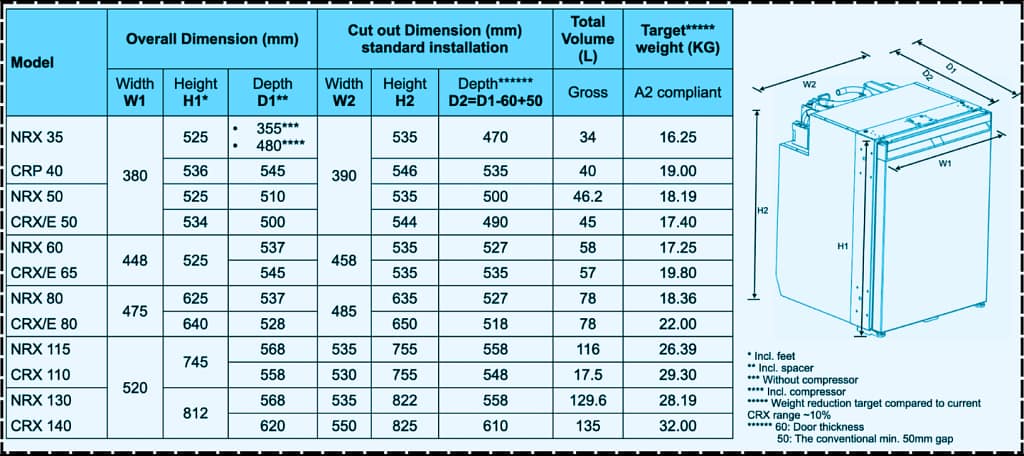
Why Dimensions Are Your Most Critical Decision
Buying a new refrigerator is a significant investment, and few things are more frustrating than the dreaded “it doesn’t fit.” Getting the dimensions wrong can lead to a cascade of problems: doors that won’t open fully, handles that scrape against adjacent cabinets, or an appliance that juts awkwardly into your walkway, defeating the purpose of a sleek, integrated kitchen.
These common installation mistakes are almost always preventable with precise knowledge of counter depth refrigerator dimensions. Understanding the nuances of depth, including the doors and handles, is the key to a successful installation. Let’s break down the exact counter depth refrigerator dimensions and how to measure your kitchen for the perfect fit.
What Are Standard Counter Depth Refrigerator Dimensions?
Standard counter depth refrigerators are engineered to create a seamless, built-in appearance by sitting nearly flush with your standard 24-inch deep kitchen counters and cabinets.
Average Size Range
The following table outlines the typical counter depth refrigerator dimensions you can expect from most major brands. (Source: The Home Depot)
| Measurement | Range | Description |
|---|---|---|
| Width | 30 – 36 inches | Varies significantly by door style (French Door, Side-by-Side, etc.). |
| Height | 67 – 72 inches | Must be selected in relation to your overhead cabinet height. |
| Depth (without doors) | 24 – 30 inches | This is the “cabinet depth” that gives the flush look. |
| Depth (with doors) | 27 – 31 inches | Includes the door and handle; crucial for clearance. |
Why “Counter Depth” Matters
The primary benefit of a counter depth fridge is its aesthetic and functional appeal. By sitting flush with your cabinet lines, it creates a streamlined, custom look that enhances the flow of your kitchen. This is especially valuable in smaller kitchens, where every inch counts, as it reduces obstructions and makes movement around the appliance easier and safer. (Source: Whirlpool)
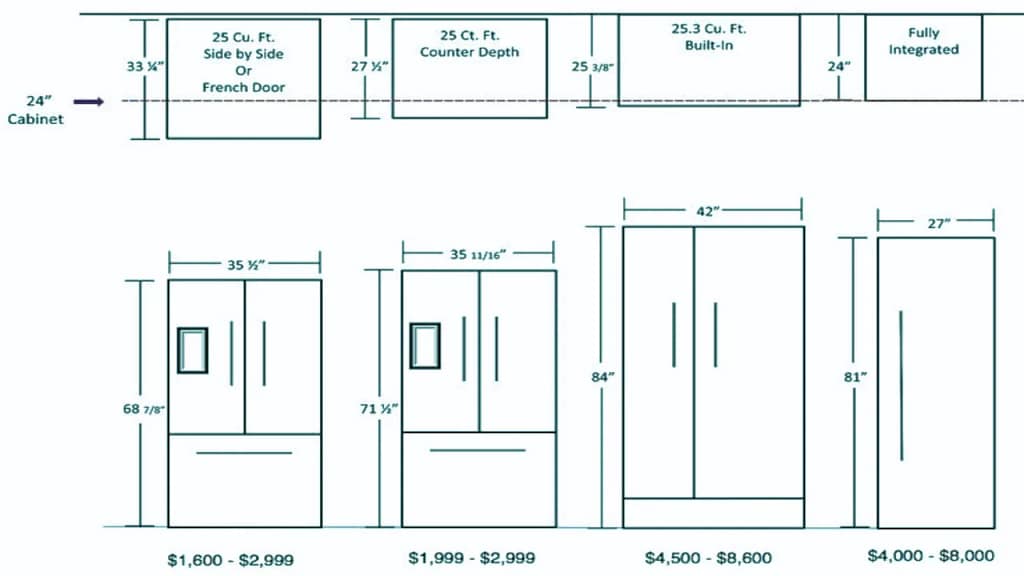
Counter Depth vs Standard Depth Refrigerator Dimensions
The most fundamental decision is choosing between counter depth and standard depth. The difference is more than just looks; it impacts capacity and footprint. Understanding counter depth refrigerator dimensions can help you make a better comparison when selecting the right fit for your kitchen.
| Feature | Counter Depth | Standard Depth |
|---|---|---|
| Depth | 24 – 30 inches | 30 – 36 inches |
| Capacity | 20 – 25 cu. ft. (on average) | 25 – 30+ cu. ft. |
| Fit | Flush with counters | Sticks out 5 – 6+ inches |
| Look | Sleek, integrated, modern | Traditional, prominent |
| Ideal For | Small kitchens, open floor plans, modern aesthetics | Large families needing maximum storage, larger kitchens |
As the table shows, the trade-off for a sleeker profile is often internal capacity. Standard depth models generally offer more cubic feet of storage because the cabinet is deeper. However, innovative interior designs in modern counter depth models help maximize space efficiency.
👉 CTA: Learn more about the differences in our Counter Depth vs Standard Refrigerator Guide.
Measuring Your Kitchen Space Like a Pro
Accurate measurement is non-negotiable. A mistake of even half an inch can lead to a non-functional appliance.
Understanding Counter Depth Refrigerator Dimensions
Before you start measuring, it helps to understand basic counter depth refrigerator dimensions so you can compare them with your available kitchen space.
Step-by-Step Measurement Process
- Measure Width: Record the total width of the space where the fridge will go, from wall to wall or between cabinets. Remember to account for any baseboards.
- Measure Height: Measure from the floor to the bottom of any upper cabinets. If there is no cabinet, note the ceiling height. Also, check if there is a ventilation soffit above the space.
- Measure Depth: Measure from the back wall (accounting for outlets) to the very front of your countertops.
- Door Swing Clearance: This is critical. Ensure you have at least 2 inches of extra space beyond the fridge’s “depth with doors” measurement for the doors to open beyond 90 degrees.
- Ventilation Space: Refrigerators need airflow to function efficiently. Most manufacturers recommend a minimum of 1-2 inches of clearance at the back and ½ inch on the sides for proper ventilation. (Source: LG)
Tools You’ll Need
- A quality metal tape measure.
- A notepad and pen to record all measurements.
- A level to ensure your floor is even.
Dimension Chart by Refrigerator Type
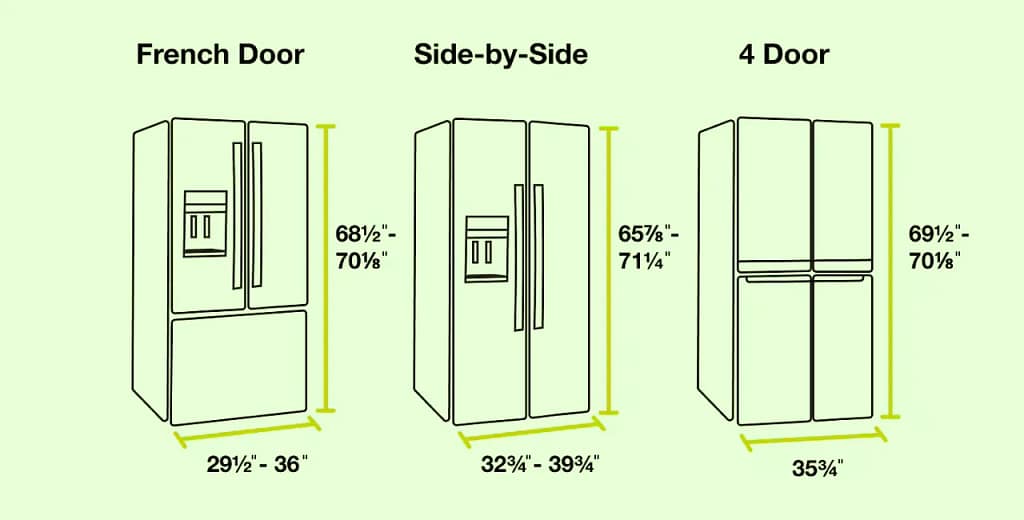
The counter depth refrigerator dimensions vary by style, which impacts both aesthetics and capacity. Here’s a breakdown.
| Type | Width | Height | Depth | Ideal Kitchen Type |
|---|---|---|---|---|
| French Door | 35 – 36″ | 69 – 71″ | 29 – 30″ | Large, modern kitchens; popular for easy access. |
| Side-by-Side | 32 – 36″ | 68 – 70″ | 28 – 30″ | Narrow layouts where wide door swings are an issue. |
| Bottom Freezer | 30 – 33″ | 67 – 70″ | 28 – 29″ | Small families; offers refrigerator at eye level. |
| Top Freezer | 28 – 32″ | 65 – 69″ | 28 – 30″ | Compact apartments and budget-conscious projects. |
How to Choose the Right Size For Your Needs
Beyond the physical footprint, the internal capacity and your kitchen’s layout are paramount. Understanding basic counter depth refrigerator dimensions can also help you ensure the model fits seamlessly into your kitchen space.
Consider Storage Capacity
Use your household size as a general guide for capacity needs:
- 18 – 20 cu. ft.: Ideal for singles or couples.
- 22 – 25 cu. ft.: Perfect for a family of 3-4.
- 26 – 30 cu. ft.: Best for large families or those who entertain frequently or buy in bulk.
Kitchen Layout Tips
Always consider the “working triangle” (the distance between sink, stove, and refrigerator). Ensure the fridge door can open fully without hitting a nearby island, wall, or other appliance like an oven or dishwasher. Also, check that adjacent drawers and cabinets can open completely.
Counter Depth Refrigerator Depth Confusion Explained
The term “depth” is the most common source of confusion when discussing counter depth refrigerator dimensions. There are two key measurements:
- Cabinet Depth (or Box Depth): This is the depth of the refrigerator’s main body, typically 24-30 inches. This is the measurement that aligns with your counters.
- Total Depth (with Doors and Handles): This includes the fully opened door and the protrusion of the handle. This is the most important measurement for ensuring you have enough walkway space.
To achieve a truly “flush look,” you must focus on the cabinet depth. However, to ensure functionality, you must plan for the total depth when the door is open. Always check the manufacturer’s specifications for both numbers. (Source: KitchenAid)
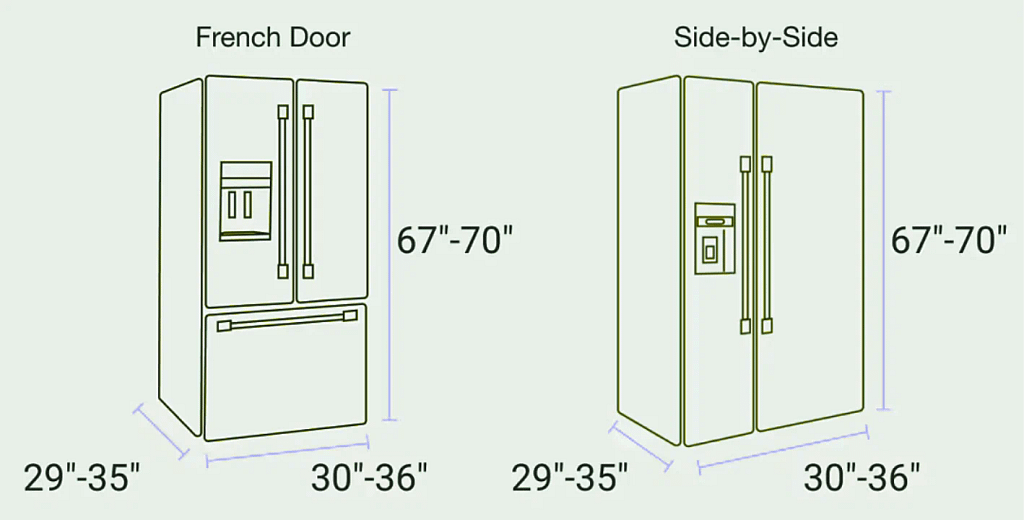
Installation Clearance Guide
Proper clearance is not a suggestion; it’s a requirement for performance and safety.
| Position | Minimum Clearance |
|---|---|
| Sides | ½ inch |
| Back | 1 – 2 inches |
| Top | 1 inch |
| Front | Door swing clearance (2–3 inches) |
This space allows for adequate air circulation around the condenser coils, which prevents the compressor from overworking and extends the life of your appliance. It also ensures doors and drawers can open smoothly.
👉 Anchor Text Suggestion: For a detailed step-by-step process, read our Counter Depth Refrigerator Installation & Maintenance Guide.
Space-Saving & Custom Fit Ideas
If your space is challenging, consider these solutions:
- Built-in Cabinet Alignment: For a truly custom look, work with a cabinetmaker to build out the surrounding cabinetry to match the fridge’s depth exactly.
- Flush-Mount Trim Kits: Some panel-ready models allow you to attach custom cabinet panels, making the refrigerator disappear entirely into your kitchen’s design.
- Smaller Options: Brands like Bosch and Beko often offer sleek, European-style models that are perfectly suited for condos and apartments with tighter counter depth refrigerator dimensions. (Source: Bosch Home)
Common Dimension Mistakes to Avoid
Learn from the errors of others:
- Measuring Only the Cabinet Opening: The biggest mistake is not accounting for the door and handle depth. Always use the “Total Depth” for planning.
- Ignoring the Electrical Outlet: Forgetting about the plug and outlet at the back can push the fridge out an extra inch, ruining the flush look.
- Buying an Oversized Fridge: It seems obvious, but many people forget to measure hallways, stairwells, and doorframes to ensure the new unit can actually be delivered into the kitchen.
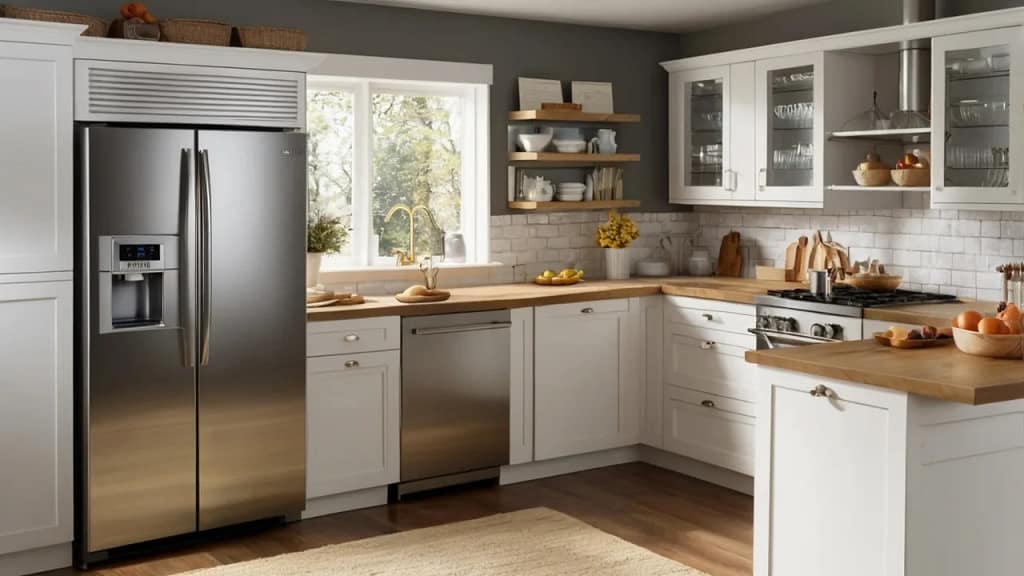
Counter Depth Refrigerator Dimensions FAQs
What is the standard counter depth refrigerator size?
The standard counter depth refrigerator size has a cabinet depth of 24 to 30 inches, a width of 30 to 36 inches, and a height of 67 to 72 inches. When evaluating models, it helps to compare these numbers with general counter depth refrigerator dimensions to ensure a proper fit. The total depth with doors and handles typically adds another 3-4 inches.
How deep is a counter depth refrigerator with handles?
A counter depth refrigerator with doors and handles is usually between 27 and 31 inches deep. You must check the manufacturer’s specification sheet for the exact “depth with handle” measurement for your model.
Will a 36-inch counter depth refrigerator fit a 36-inch space?
No, you should not install a 36-inch wide refrigerator into a 36-inch wide space. You must account for ventilation and installation clearance. A 36-inch fridge typically requires an opening of about 37 to 38 inches wide for a proper fit. (Source: GE Appliances)
What size counter depth refrigerator fits small kitchens?
For small kitchens, look for top freezer or bottom freezer models with widths between 28 and 33 inches and capacities around 18 to 22 cubic feet. These models offer the best balance of storage and space-saving counter depth refrigerator dimensions.
How much clearance do I need behind my refrigerator?
You need at least 1 to 2 inches of clearance behind your refrigerator for proper ventilation and to accommodate the power cord. Always refer to your specific model’s installation guide for the manufacturer’s recommendation.
Conclusion + CTA
Understanding the precise counter depth refrigerator dimensions is the most critical step in achieving a kitchen that is both beautiful and functional. A counter depth model offers a space-saving, modern look that integrates seamlessly into your cabinetry. By taking the time to measure twice, understand depth distinctions, and account for clearances, you can ensure a perfect fit that will deliver long-term performance and satisfaction.
👉 CTA: Before buying, measure twice and check our Counter Depth Refrigerator Buying Guide to choose your ideal size.